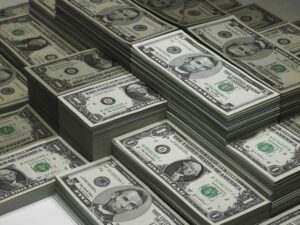Dollar Stabilizes as Investors Assess U.S. Interest Rate Outlook; Kiwi Falls Post-RBNZ Decision
The U.S. dollar moved sideways on Wednesday, offering a breather to major currencies like the yen, following a sharp rally to a seven-week high last week. Investors are closely monitoring the U.S. interest rate outlook.
New Zealand Dollar Drops to Seven-Week Low
The New Zealand dollar (NZD) fell to its lowest point since August 19, trading at $0.60705. This came after the Reserve Bank of New Zealand (RBNZ) cut interest rates by 50 basis points and signaled potential for more aggressive monetary easing in the future.
U.S. Data and Rate Expectations
This week’s light U.S. data schedule offers a pause after Friday’s robust jobs report, which led to the dollar’s rally. The report tempered expectations for a significant near-term interest rate cut by the Federal Reserve.
Later on Wednesday, investors anticipate the release of the Federal Reserve’s September meeting minutes, which will shed light on the discussions surrounding what was then perceived as a weakening labor market. The meeting concluded with a 50-basis point rate cut, supported by most policymakers.
Market Reaction to Strong Jobs Data
Following the stronger-than-expected nonfarm payrolls data, markets have reevaluated their rate cut expectations. According to the CME FedWatch tool, there’s now an 85% chance of a quarter-point reduction, with a slim possibility the Federal Reserve might leave rates unchanged.
Upcoming U.S. Inflation Data
The U.S. Consumer Price Index (CPI) report for September, scheduled for release on Thursday, is the key data point for the week. Analysts from Westpac IQ noted that inflation data and upcoming corporate earnings will be crucial to sustaining the U.S. dollar’s strength and reinforcing the narrative of U.S. economic resilience.
Dollar Index and Currency Movements
The U.S. dollar index, which tracks the greenback against a basket of currencies, edged higher by 0.11% to 102.6, just shy of last Friday’s seven-week high of 102.69. The euro slipped 0.07% to $1.0973, while the British pound traded mostly flat at $1.3099.
The dollar/yen pair ticked up 0.19% to 148.475 yen, following its seven-week high of 149.10 reached earlier this week. Analysts expect caution in the yen market due to uncertainties surrounding the upcoming elections in Japan and the U.S.
Japan’s Political and Monetary Developments
Japan’s new Prime Minister, Shigeru Ishiba, known for his opposition to loose monetary policy, surprised markets with recent remarks signaling hesitancy on future rate hikes. Ishiba has called for a snap election on October 27, which will occur just before the Bank of Japan’s monetary policy meeting and the U.S. presidential election in November.
Kiwi Dollar Reacts to RBNZ’s Dovish Stance
The New Zealand dollar dropped 0.5% to $0.61055 after the RBNZ’s dovish policy signal. Investors expect further rate cuts in the coming months, in line with a Reuters poll predicting the 50-basis point cut on Wednesday.
Australian Dollar and China’s Economic Outlook
The Australian dollar initially fell toward Tuesday’s three-week low of $0.6715 before recovering slightly to trade at $0.6726. This came after news that China’s finance ministry will hold a press conference on fiscal policy. Investors remain focused on China following volatility in Chinese and Hong Kong markets.
Beijing has stated its confidence in meeting its annual growth targets but has refrained from introducing stronger fiscal measures, leading to investor disappointment. The offshore yuan slipped 0.28% to 7.0550 per dollar.




















